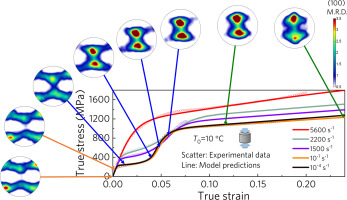当前位置:
X-MOL 学术
›
Mater. Des.
›
论文详情
Our official English website, www.x-mol.net, welcomes your
feedback! (Note: you will need to create a separate account there.)
Strain rate dependent mechanical response for monoclinic NiTi shape memory alloy: Micromechanical decomposition and model validation via neutron diffraction
Materials & Design ( IF 7.6 ) Pub Date : 2020-06-01 , DOI: 10.1016/j.matdes.2020.108656 Zhaolong Yang , Hong Wang , Yalin Huang , Xiangping Ye , Jian Li , Changsheng Zhang , Hongjia Li , Beibei Pang , Yi Tian , Chaoqiang Huang , Guangai Sun
Materials & Design ( IF 7.6 ) Pub Date : 2020-06-01 , DOI: 10.1016/j.matdes.2020.108656 Zhaolong Yang , Hong Wang , Yalin Huang , Xiangping Ye , Jian Li , Changsheng Zhang , Hongjia Li , Beibei Pang , Yi Tian , Chaoqiang Huang , Guangai Sun

|
Abstract Design of shape memory alloy based structure in high–frequency or dynamic applications needs to build on a luminous comprehension for high speed deformation mechanisms of the corresponding material. In present work, dynamic responses and bulk texture evolutions are studied in martensitic NiTi through multi–scale characterization efforts. The objective is to quantitatively decompose the macroscopic strain according to deformation mechanisms and construct a phenomenological constitutive model. This study uses quasi–static in–situ and dynamic ex–situ neutron diffraction techniques to follow the evolution of bulk texture, twin volume fraction, and active twinning modes under various strain rates. It is demonstrated that the mechanical responses are strongly rate sensitive. The observation is attributed to the variation in slip activity. A distinct twinning mode change during compression is captured through in–situ neutron diffraction, and the shear induced reorientation is well described. Based on experimental observations, a constitutive model that includes effects of elasticity, reorientation of accommodation twinning, and plasticity is constructed and validated in a wide strain rate range. The overall results provide insights into strain rate dependent mechanical response of martensitic NiTi in both experiment and model aspects. This work will guide the design and application of shape memory alloys, especially in dynamic condition.
中文翻译:

单斜 NiTi 形状记忆合金的应变率相关机械响应:通过中子衍射进行微机械分解和模型验证
摘要 在高频或动态应用中设计基于形状记忆合金的结构需要建立在对相应材料的高速变形机制的理解之上。在目前的工作中,通过多尺度表征工作研究了马氏体 NiTi 中的动态响应和整体织构演变。目的是根据变形机制对宏观应变进行定量分解,构建唯象本构模型。本研究使用准静态原位和动态非原位中子衍射技术来跟踪不同应变率下的体结构、孪晶体积分数和活性孪晶模式的演变。结果表明,机械响应对速率非常敏感。该观察结果归因于滑动活动的变化。通过原位中子衍射捕获了压缩过程中明显的孪生模式变化,并且很好地描述了剪切引起的重定向。基于实验观察,构建了一个包括弹性效应、调节孪晶重新定向和塑性效应的本构模型,并在很宽的应变率范围内进行了验证。总体结果提供了对马氏体 NiTi 在实验和模型方面的应变率相关机械响应的见解。这项工作将指导形状记忆合金的设计和应用,特别是在动态条件下。调整孪生和塑性的重新定向,在很宽的应变率范围内构建和验证。总体结果提供了对马氏体 NiTi 在实验和模型方面的应变率相关机械响应的见解。这项工作将指导形状记忆合金的设计和应用,特别是在动态条件下。调整孪生和塑性的重新定向,在很宽的应变率范围内构建和验证。总体结果提供了对马氏体 NiTi 在实验和模型方面的应变率相关机械响应的见解。这项工作将指导形状记忆合金的设计和应用,特别是在动态条件下。
更新日期:2020-06-01
中文翻译:

单斜 NiTi 形状记忆合金的应变率相关机械响应:通过中子衍射进行微机械分解和模型验证
摘要 在高频或动态应用中设计基于形状记忆合金的结构需要建立在对相应材料的高速变形机制的理解之上。在目前的工作中,通过多尺度表征工作研究了马氏体 NiTi 中的动态响应和整体织构演变。目的是根据变形机制对宏观应变进行定量分解,构建唯象本构模型。本研究使用准静态原位和动态非原位中子衍射技术来跟踪不同应变率下的体结构、孪晶体积分数和活性孪晶模式的演变。结果表明,机械响应对速率非常敏感。该观察结果归因于滑动活动的变化。通过原位中子衍射捕获了压缩过程中明显的孪生模式变化,并且很好地描述了剪切引起的重定向。基于实验观察,构建了一个包括弹性效应、调节孪晶重新定向和塑性效应的本构模型,并在很宽的应变率范围内进行了验证。总体结果提供了对马氏体 NiTi 在实验和模型方面的应变率相关机械响应的见解。这项工作将指导形状记忆合金的设计和应用,特别是在动态条件下。调整孪生和塑性的重新定向,在很宽的应变率范围内构建和验证。总体结果提供了对马氏体 NiTi 在实验和模型方面的应变率相关机械响应的见解。这项工作将指导形状记忆合金的设计和应用,特别是在动态条件下。调整孪生和塑性的重新定向,在很宽的应变率范围内构建和验证。总体结果提供了对马氏体 NiTi 在实验和模型方面的应变率相关机械响应的见解。这项工作将指导形状记忆合金的设计和应用,特别是在动态条件下。











































 京公网安备 11010802027423号
京公网安备 11010802027423号